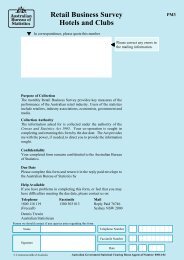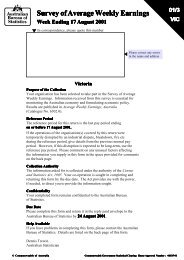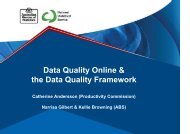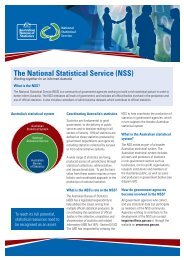SAE Manual Sections 1 to 4_1 (May 06).pdf - National Statistical ...
SAE Manual Sections 1 to 4_1 (May 06).pdf - National Statistical ...
SAE Manual Sections 1 to 4_1 (May 06).pdf - National Statistical ...
Create successful ePaper yourself
Turn your PDF publications into a flip-book with our unique Google optimized e-Paper software.
A Guide <strong>to</strong> Small Area Estimation - Version 1.1 05/05/20<strong>06</strong><br />
3. Some issues in Small Area Estimation<br />
3.1 Sources of Additional Information<br />
The aim of small area estimation is <strong>to</strong> output a set of reliable estimates for each small<br />
area for the target variable(s) of interest. The challenge therefore, in small area<br />
estimation, is how best <strong>to</strong> use innovative approaches that take advantage of additional<br />
information <strong>to</strong> circumvent the small sample size problem and provide estimates with<br />
improved quality. Small area estimation methods are effective when they can draw upon<br />
intrinsic relationships within and between the survey data and other data sources, from<br />
which they borrow strength. These relationships, which are schematically represented in<br />
Figure 3.1, may be found:<br />
o<br />
o<br />
o<br />
o<br />
o<br />
between the survey based direct estimate and auxiliary information available from<br />
administrative data sources, censuses or other surveys or<br />
in correlations between direct estimates observed across time or<br />
in spatial relationships between neighbouring small areas or<br />
in cross-sectional relationships between units with similar characteristics observed in<br />
different small areas within some broader region<br />
or any combinations of the above.<br />
Figure 3.1: Possible sources of additional information<br />
Auxiliary Data<br />
(Demographic<br />
Information)<br />
Cross-sectional<br />
Relationships<br />
Small<br />
Area<br />
Model<br />
Time Series<br />
Relationships<br />
Multivariate<br />
Correlations<br />
Spatial<br />
Effects<br />
It turns out that, in most cases, by far the most important source from which <strong>to</strong> borrow<br />
strength, is the use of auxiliary data.<br />
Auxiliary data<br />
Australian Bureau of Statistics 14








